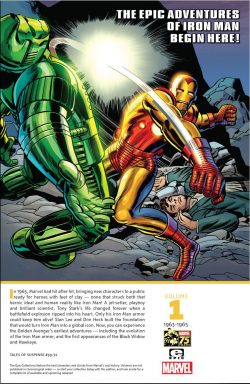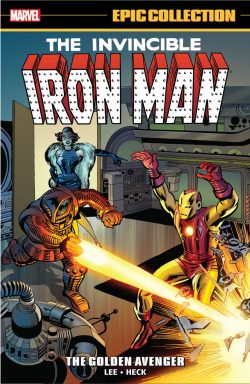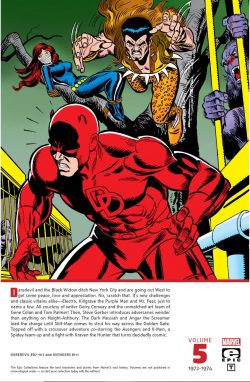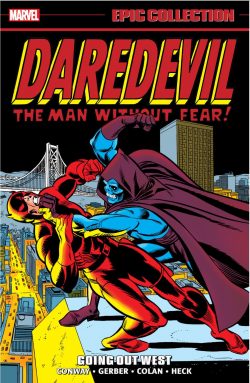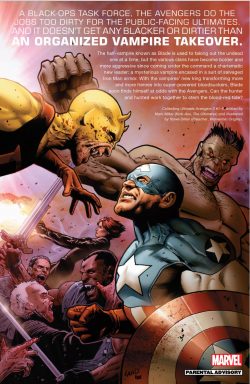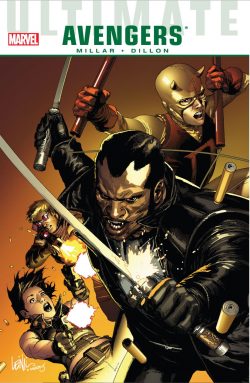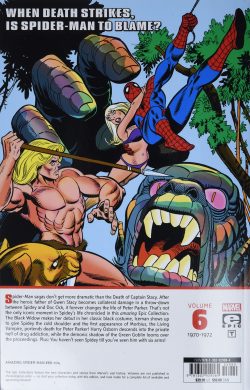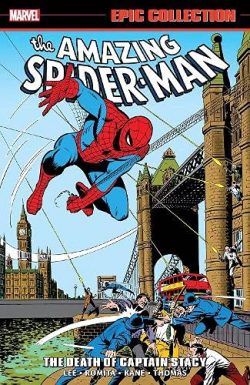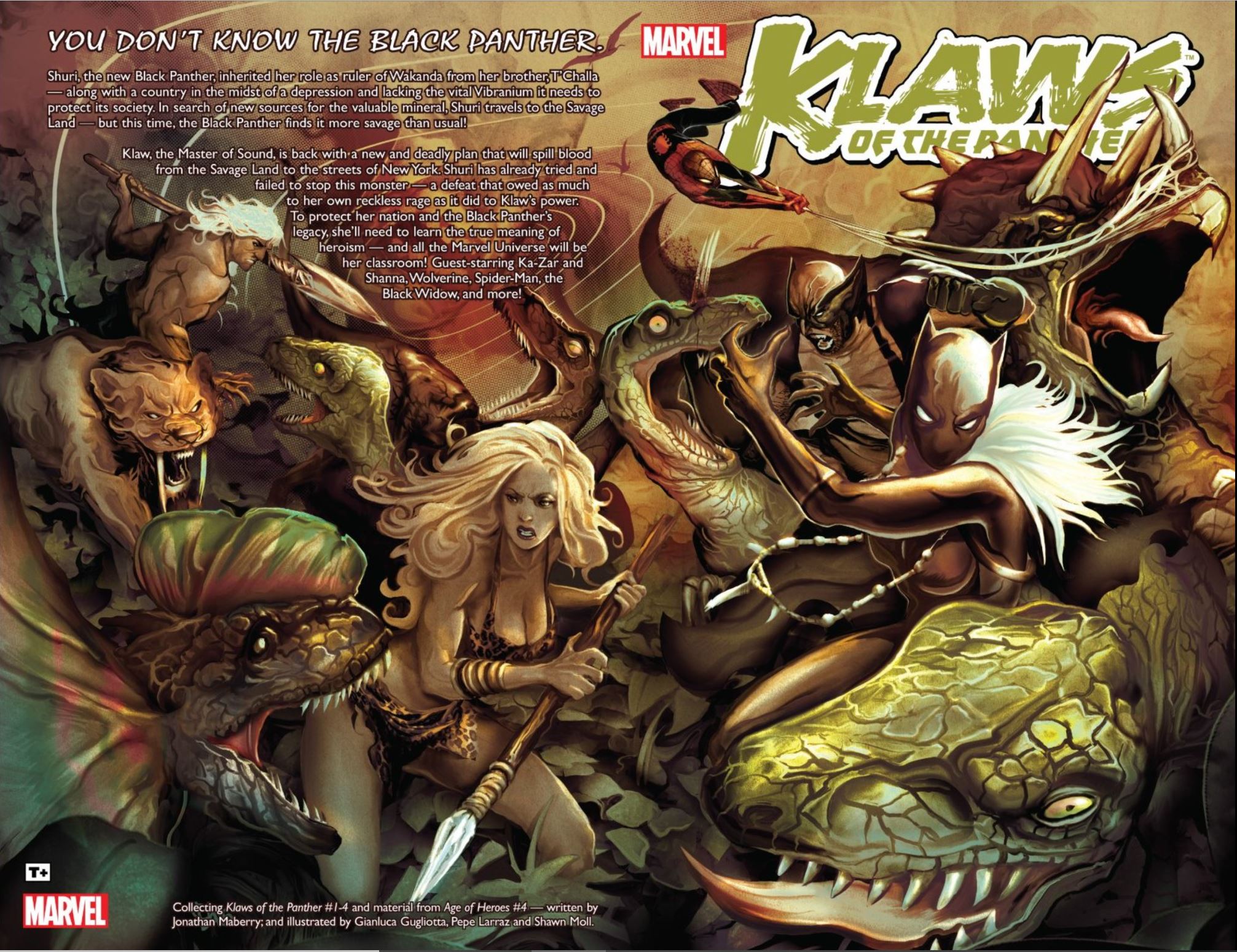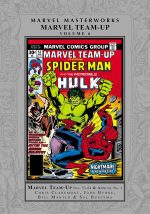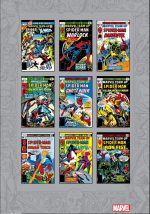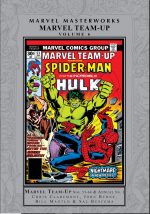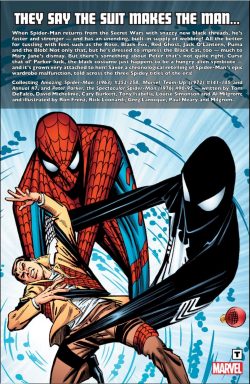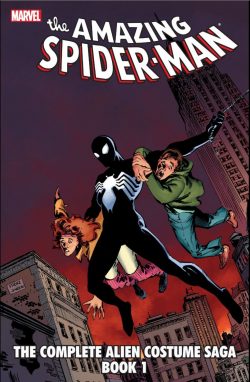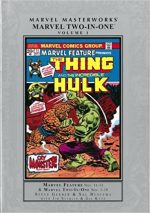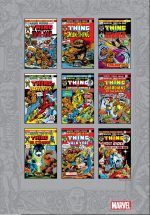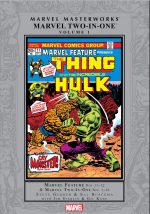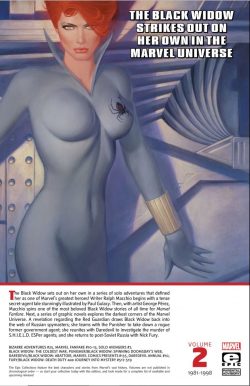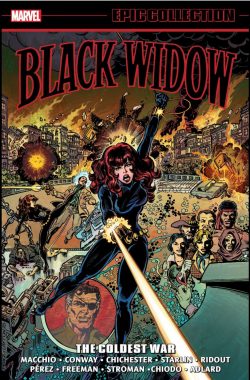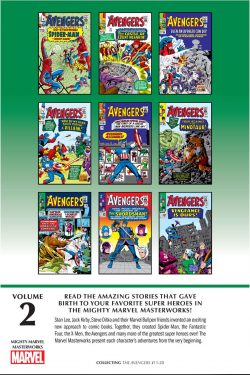
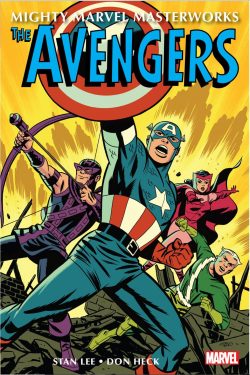
By Stan Lee, Larry Lieber, Larry Ivie, Don Heck, Jack Kirby, Dick Ayers, Chic Stone, Mike Esposito, Wallace Wood & various (MARVEL)
ISBN: 978-1-3029-4613-5 (PB/Digital edition)
Probably Marvel’s biggest global franchise success, The Avengers celebrate their 60th anniversary in 2023, so let’s again acknowledge that landmark event and offer a promise of more of the same…
These stories are timeless and have been gathered many times before but here we’re enjoying an example of The Mighty Marvel Masterworks line: designed with economy in mind and newcomers as target audience. These books are far cheaper, on lower quality paper and smaller – like a paperback novel. Your eyesight might be failing and your hands too big and shaky, but at 152 x 227mm, they’re perfect for kids. If you opt for the digital editions, that’s no issue at all.
After a period of meteoric expansion, in 1963 the burgeoning Marvel Universe was finally ready to emulate the successful DC concept that had cemented the legitimacy of the Silver Age of American comics. The notion of putting a bunch of all-star eggs in one basket had made the Justice League of America a winner and subsequently inspired the moribund Atlas outfit – primarily Stan Lee, Jack Kirby & Steve Ditko – into conceiving “super-characters” of their own. The result – way back in 1961 – was the Fantastic Four…
After 18 months, the fledgling House of Ideas had generated a small successful stable of costumed leading men (but still only 2 sidekick women!), allowing Lee & Kirby to at last assemble a select handful of them into an all-star squad, moulded into a force for justice and soaring sales…
Cover dated September 1963, and on sale from Early July, The Avengers #1 launched as part of an expansion package which also included Sgt. Fury and his Howling Commandos and The X-Men. This sequel edition collects The Avengers #11-20 (cover-dates December 1964 to September 1965): a stellar sequence of groundbreaking tales no lover of superhero stories can do without…
The tense action resumes with the team supreme of Iron Man, Thor, Captain America, Ant-Man & the Wasp still together after numerous attempts to destroy them or shatter their unity. An eagerly anticipated meeting delighted fans when #11 declared ‘The Mighty Avengers Meet Spider-Man!’: a clever and classy cross-fertilising tale from Lee and Don Heck, inked by Chic Stone. It features the return of the time-bending tyrant Kang the Conqueror, who attempts to destroy the team by insinuating a robotic duplicate of the outcast arachnid within their serried ranks. It’s accompanied by Heck’s Marvel Master Work Pin-up of ‘Kang!’ and preceded a cracking end-of-the-world thriller with guest-villains Mole Man and the Red Ghost, doing their very best to avoid another clash with the Fantastic Four.
This was another potent Marvel innovation, as – according to established funnybook rules – bad guys stuck to their own nemeses and didn’t clash outside their own backyards…
Inked by Dick Ayers, ‘This Hostage Earth!’ is a welcome return to grand adventure with lesser lights Giant-Man and the Wasp taking rare lead roles, but is trumped by a rousing gangster thriller of a sort seldom seen outside the pages of Spider-Man or Daredevil. The saga premiered Marvel universe Mafia analogue The Maggia and another major menace in #13’s ‘The Castle of Count Nefaria!’
After crushingly failing in his scheme to frame the Avengers, Nefaria’s caper ends on a tragic cliffhanger as Janet Van Dyne is left gunshot and dying, leading to a peak in melodramatic tension in #14 – scripted by Larry Ivie (as Paul Laiken) & Larry Lieber over Stan’s plot – as the traumatised team scour the globe for the only surgeon who can save her.
‘Even Avengers Can Die!’ – although of course she doesn’t – resolves into an epic alien invasion tale with overtones of This Island Earth, with Kirby stepping in to lay out the saga for Heck & Stone to illustrate. This only whets the appetite for the classic climactic confrontation that follows one month later as the costumed champions finally deal with the Masters of Evil and Captain America at last avenges the death of his dead partner Bucky.
‘Now, by My Hand, Shall Die a Villain!’ in #15 (laid-out by Kirby, pencilled by Heck and inked by Mike Esposito) features the final, fatal confrontation between Cap and Baron Zemo in the heart of the Amazon, whilst the other Avengers and the war-criminal’s cohort of masked menaces (Enchantress, Executioner, Black Knight and The Melter) battle once more on the streets of New York City…
It all ends as ‘The Old Order Changeth!’ (broken down by Kirby before being finished by Ayers) presages a dramatic change in concept for the series; presumably because, as Lee increasingly wrote to the company’s unique strengths – tight continuity and strongly individualistic characterisation – he found juggling individual stars in their own titles as well as a combined team episode every month was just incompatible if not impossible…
As Cap and substitute sidekick Rick Jones fight their way back to civilisation, the Avengers institute changes. The big-name stars retire and are replaced by three erstwhile villains: Hawkeye, Quicksilver and The Scarlet Witch.
Eventually, led by perennial old soldier Captain America, this relatively powerless group with no outside titles to divide the attention (the Sentinel of Liberty did have a regular feature in Tales of Suspense but at that time it featured adventures set during WWII) evolved into another squabbling family of flawed, self-examining neurotics, enduring extended sub-plots and constant action as valiant underdogs; a formula readers of the time could not get enough of and which still works today…
Acting on advice from the departing Iron Man, the neophytes seek to recruit The Hulk to add raw power to the team, only to be ambushed by Mole Man in #17’s ‘Four Against the Minotaur!’ (Lee, Heck & Ayers), after which they fall foul of a dastardly “commie” plot ‘When the Commissar Commands!’ – necessitating a quick trip to thinly-disguised Viet Nam analogue Sin-Cong to unwittingly battle a bombastic android…
These relatively low-key tales are followed by an ever-improving run of mini-masterpieces, the first of which wraps up this compilation with a 2-part gem providing Hawkeye’s origin and introducing a roguish hero/villain.
‘The Coming of the Swordsman!’ introduces a dissolute, disreputable swashbuckler – with just a hint of deeply-buried flawed nobility – who attempts to force his way onto the highly respectable team to avoid outstanding international arrest warrants. His immediate and total rejection leads to him becoming an unwilling pawn of a far greater menace after being kidnapped by A-list would-be world despot The Mandarin.
The conclusion comes in the superb ‘Vengeance is Ours!’ – sublimely inked by the one-&-only Wally Wood – wherein the constantly-bickering Avengers finally pull together as a supernaturally efficient, all-conquering team…
These are immortal tales that defined the early Marvel experience and are still a joy no fan should deny themselves or their kids. How can you survive without them?
© 2022 MARVEL.

